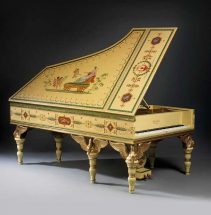Cellos. The violin family, including cello-sized instruments, emerged c. 1500 as family of instruments distinct from the viola da gamba family. The earliest depictions of the violin family, from northern Italy c. 1530, show three sizes of instruments, roughly corresponding to what we now call violins, violas, and cellos. Contrary to a popular misconception, the cello did not evolve from the viola da gamba, but existed alongside it for about two and a half centuries. The violin family is also known as the viola da braccio (meaning viola of the arm) family, a reference to the primary way the members of the family are held. This is to distinguish it from the viola da gamba (meaning viola of the leg) family, in which all the members are all held with the legs. The likely predecessors of the violin family include the lira da braccio and the rebec. The earliest surviving cellos are made by Andrea Amati, the first known member of the celebrated Amati family of luthiers.
The direct ancestor to the violoncello was the bass violin. Monteverdi referred to the instrument as “basso de viola da braccio” in Orfeo (1607). Although the first bass violin, possibly invented as early as 1538, was most likely inspired by the viol, it was created to be used in consort with the violin. The bass violin was actually often referred to as a “violone”, or “large viola”, as were the viols of the same period. Instruments that share features with both the bass violin and the viola da gamba appear in Italian art of the early 16th century. Reference: Wikipedia
Cello made by Robert William Crook Made by Crook, Robert William in Sydney, New South Wales, Australia, 1887. This cello is significant as an example of the work of Australian musical instrument maker Robert William Crook who worked in Sydney from about the late 1870s until the 1890s. He is one of only a very small number of makers making bowed string instruments in Sydney during this time. This instrument is also significant as it is the only Australian-made cello from the nineteenth century to be in the Museum’s extensive musical instrument collection.
Reference: Museum of Applied Art and Sciences
SANTO SERAFIN (B UDINE, 1699; D 1758) A CELLO, VENICE, CIRCA 1741 labelled Sanctus Seraphin Utinensis Fecit Venetijs Ann. 1741 and branded Santo Serafin by the end pin Sold with a photocopy of the certificate of Hamma & Co., Stuttgart, dated 17th January 1977.
Sold for 610,000 GBP at Sotheby’s in 2018
‘Belly of two pieces of pine, back of two pieces of sycamore. Inlaid purfling of two black lines and one light. The body has been altered from its original shape. The later neck shows much use, and the pegholes have twice been plugged and redrilled’ – Anthony Baines: Catalogue of Musical Instruments in the Victoria and Albert Museum – Part II: Non-keyboard instruments (London, 1998), p. 19.
By about 1750, the ‘cellos had largely replaced the bass viol as the main source of lower range notes in the string section of an orchestra or ensemble. This instrument belonged to Jean Gérardy (1877 – 1929), a leading Belgian cellist who toured extensively throughout Europe and America from about 1890 until 1920. Although it has a 1711 Stradivarius label, this instrument was probably made in Venice some time later on in the 18th century.
Reference: © Victoria and Albert Museum
An English Cello of the Kennedy School, London circa 1820 Length of back 732mm (28 13/16in) pleasing work of a golden orange brown colour, use, wear and restoration, with a cello bow in hard black case.
Sold for £ 8,750 inc. premium at Bonhams in 2015
A REGENCY VIOLONCELLO WORKSHOP OF THOMAS DODD, CIRCA 1820 With original label to interior, ‘T.DODD. VIOLIN, VIOLONCELLO & BOW MAKER. NEW STREET, COVENT GARDEN’, with original pine case Length of back, 29 3/8 in. (74.6 cm.)
Sold for GBP 27,500 at Christie’s in 2012
Cello, inscribed on a label inside the body ”Fait sous la direction de Paul Jombar Luthier, 20 Rue Rochechouart a Paris”, instrument has been newly overhauled, new strings. In dark red leatherette bag with zipper, without bow
Sold for €1,300 at Historia Auctionata in 2019







